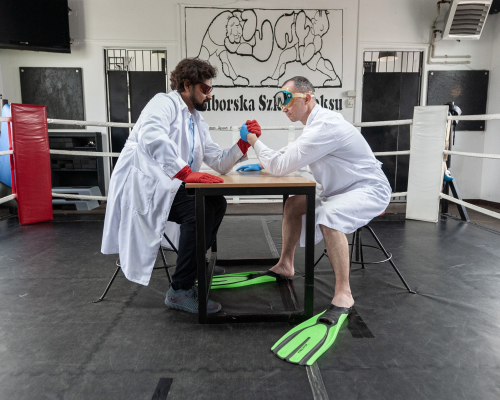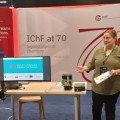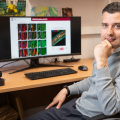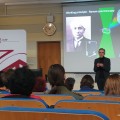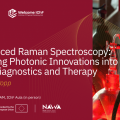Lu(a)minar Flow Odyssey – the power of water and light towards early leukemia diagnostics
Reading time: about 9 minuts
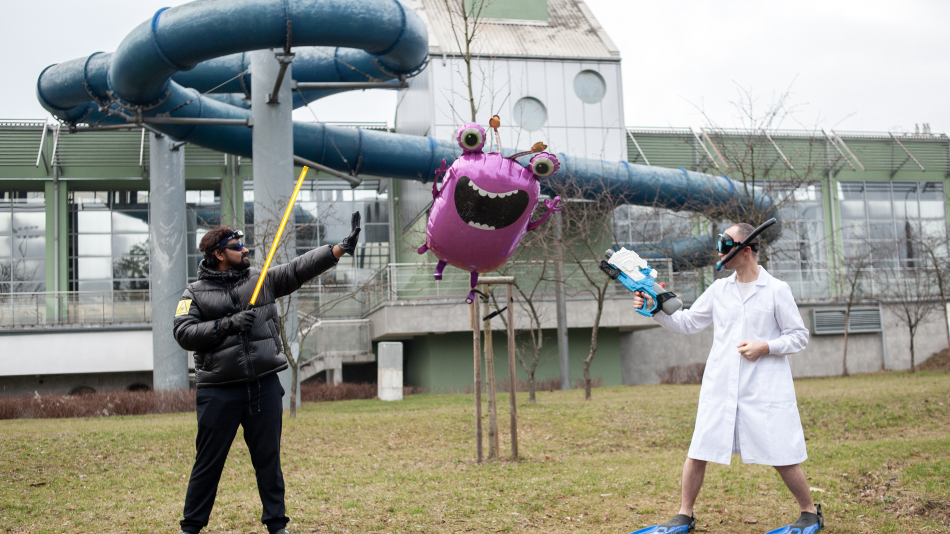
A research team from the Institute of Physical Chemistry of the Polish Academy of Sciences have demonstrated a unique configuration of a system based on optical tweezers – which enables long-distance manipulation of various particles and cells in lab-on-the-chip devices – to enable fast and effective diagnosis and treatment of many serious diseases.
Cancer is the scourge of the 21st century, and despite the rapid development in medical diagnostics and personalized treatments, most therapies remain insufficient to save a patient's life. Timely and accurate diagnosis is of a paramount importance, but once a patient is diagnosed, the outcome of the battle to save a life still depends on many factors. Surgery, chemotherapy, radiation therapy, heat treatment, immunotherapy, and combinations of these methods may sometimes win the battle, saving the life of a cancer patient; nonetheless, the same therapies may be ineffective for another patient. Therefore, concreted efforts are being made around the world to solve this problem. Recently, scientists at the Institute of Physical Chemistry of the Polish Academy of Sciences (IPC PAS) delivered a new solution in microfluidic devices bringing us closer to a timely and highly specific diagnosis, depending on which a therapy can be tailored on a case-by-case basis. How does it work? Let us take a closer look at the uniqueness of their findings.
It all starts with microfluidic technology, which has been studied widely over the last three decades. Manipulation of fluids in tiny channels has already found applications in analytical chemistry, synthetic biology, material science, microbiology, medical diagnostics, optics and even in information technology. Above all, however, microfluidics found its widest adaptation in microbiology and medical diagnostics, wherein its operation in the nanometer to micrometer range is perfectly suited for single cell research. Its ability to scan hundreds of thousands of cells individually in a single second revolutionized how we see individual cells, their individual and collective behaviors, and their response to drugs or changes in environmental conditions. The volume of the information microfluidics can unlock, combined with its speed, accuracy and specificity can become the difference between life and death in diagnosing deadly diseases such as cancer. This possibility of early-stage diagnosis of blood cancer – better known as leukemia – was the motivation of the Polish team in building an innovative microfluidics-based diagnostic device.
“Or at least half of the motivation…” laughs Dr Ladislav Derzsi, the leader of the microfluidics team. “The other half came from integrating microfluidics with a powerful emerging technique, called stimulated Raman spectroscopy. And this combination is what makes it a cutting-edge technology. Projects like this require a high degree of interdisciplinarity,” Dr Derzsi continues, “and as a matter of fact, we carried out this project in a consortium with six of Poland’s finest research groups from various fields. We, the microfluidics team were developing the heart of the diagnostic device: the microfluidic chip, which handles the blood cells, delivers them one-by-one to the tiny detection point of the spectrometer with exceptional accuracy, traps the cells for detection and, finally, based on the detected signals sorts the cells, isolates potentially interesting cells for further investigation. The team at Warsaw University is building the main frame of the diagnostic system – the Raman microscope; the team at the Institute of Physical Chemistry is building a one-of-its-kind pumping laser; and the fourth team, which is based in the Jagiellonian University in Krakow, is responsible for the detection and analysis of the Raman spectra. Finally, two teams, one at the Medical University of Lodz and another at the Institute of Hematology and Blood Transfusion Medicine in Warsaw, are responsible for the microbiological part, and all patient and blood-related topics of the project.”
But let us go back for a while to the “secret weapon”, the stimulated Raman spectroscopy (SRS), which puts this diagnostic system on a completely new level. Shreyas Vasantham, the first author of the study explains:
“For doctors, SRS could be a technique akin to what fingerprinting is for detectives and criminal forensics. SRS detects vibrations of the molecular bonds, which are as unique for molecules as fingerprints for people. Detecting such molecular vibrational fingerprints allows for unambiguous identification of the particular molecule to which it belongs. Cancer cells, despite their wide variety and heterogeneity, share a common feature of differing in their metabolic activities and metabolites from that of healthy cells. Building a library of related Raman spectra would allow automatized identification of cancer cells based on their Raman markers. Consequently, using SRS in diagnostics can not only reveal the presence of a developing cancer but can also provide the information of its type, sub-type, stage of development, and all necessary information to build a treatment that is tailored to a given patient.”
To successfully apply such ultra-specific diagnosis, however, there are a few technical challenges to overcome. First, the cells must be captured one by one and held very still for the time of scanning… but without touching them. Non-invasive manipulation techniques – or, as professionals refer to them, “grabbing without touching” – are applied by using dielectrophoresis, ultrasound, or laser light. Among these, the least obvious but probably most powerful method of grabbing particles and cells is light. The discovery of capturing and moving microscopic objects with the use of light only, and its development into a working technique, which became known as “optical tweezers,” earned its inventor, Arthur Ashkin, a Nobel Prize in physics in 2018.
Since its first demonstration in 1986, optical tweezers have come a long way. Technological advancements in fiber optics allowed scientists to replace the traditional microscope objective-based approaches, which are bulky and expensive, with optical fibers slightly thicker than a human hair, which fit into one’s palm, even when combined with the diode laser and all the electronics.
For an effective optical tweezer, the laser light has to be focused (and this is why microscope objectives were used), but the laser being emitted from the tip of an optical fiber is usually divergent and pushes away particles rather than attracting them. To overcome this, the available fiber optics-based approaches use one of two methods. One, deploying two fibers facing each other and pushing the cells from two opposite sides, holding them in the mid-point where the two opposing forces cancel out each other. Two, using only a single optical fiber, the tip of which is chemically etched, nano-printed, or modified to achieve focusing of the laser beam. While the dual fiber approach requires a very precise alignment of the counter-propagating beams, the sophisticated modification of the fiber’s tip and limitations of the particle’s size makes the single fiber approach less attractive.
Now, the Polish microfluidics team has demonstrated a novel, simple yet elegant approach: using a single optical fiber without any modification of its tip, save a simple, straight cut, they integrate the optical fiber directly into the microfluidic channel with its tip facing against the flow. In this configuration, the hydrodynamic drag in the microfluidic channel carries/pushes the cells straight towards the optical fiber’s tip and the laser beam propagating from the optical fiber pushes away the cells. Where these two counter-propagating forces are equal in magnitude, the net force acting on the cell is zero and the cell gets trapped. Moreover, the cells in the microchannel are sheathed from all four sides with a buffer liquid, which allows the researchers to focus the cells into a very narrow stream. When the flow rates of all four sheathing liquids are the equal, cells are pushed from each side symmetrically and the narrow steam flows in the middle of the channel. However, changing the flow rates of the sheathing liquids slightly allows us to fine-tune, i.e. dynamically align the position of, the stream of cells with the laser beam (in case the optical fiber is off axis), thus maximizing trapping efficiency.
“Our opto-hydrodynamic tweezers (OHTs) offer an improved alternative to conventional optical fiber tweezers for a wide range of applications in physics, biology, medicine, etc. By regulating the optical power and flow rates, we were able to trap single particles at desired positions in the channel with very high precision as well as manipulate them over a long-range upstream or downstream with a maximum distance of 500 μm,” claims Shreyas Vasantham, the first author of studies.
Furthermore, OHT allows much higher flow velocities of up to 4,300 μm/s compared to traditional fiber optic tweezers because the drag force is balanced by optical scattering rather than gradient force. In addition, the manipulation and movement of trapped particles over long distances of up to 500 μm is possible within the framework of controlling optical power and flow rate in the channels. Another advantage of OHT is the much lower optical radiation intensity on the manipulated particle, limiting its damage during operation.
Vasantham remarks, “Depending on the applications, particles can either be trapped and released continuously to collect information about the specimen in a high-throughput manner or a single particle can be analyzed for a long duration by stopping the sample flow while maintaining all the sheath flows. We noted that the concentration of the particles can be adjusted to maintain a specific average frequency of incoming particles in the trap such that the particle can be released after collecting the required information before the arrival of another.”
Finally, the OHT system offers a bonus feature: its ability to sort the cells after detection and isolate potentially interesting mutations allows for testing the efficacy of proposed drugs and therapies without even exposing the patient to drugs.
“OHT also offers several additional benefits over conventional optical fiber tweezers: the use of a single optical fiber as compared to two used in dual-beam fiber tweezers minimizes the overall optical radiation intensity on the particle, hence limiting damage to the trapped particle,” claims Dr. Yurii Promovych, one of the co-authors.
The proposed OHT configuration is a promising tool for use in personalized medicine, which paves the way for rapid diagnostics using lab-on-the-chip devices and sheds new light on the delivery of personalized therapies, including anti-cancer treatments.
The project was supported by the Foundation for Polish Science TEAM NET project POIR.04.04.00-00-16ED/18-00. S.V. is also grateful for the scholarship from the Institute of Physical Chemistry, Polish Academy of Sciences as part of the Warsaw4PhD initiative.
CONTACTS:
Dr. Ladislav Derzsi
Institute of Physical Chemistry of the Polish Academy of Sciences
Phone: +48 22 343 3405
email: lderzsi@ichf.edu.pl
SCIENTIFIC PAPERS:
“Opto-hydrodynamic Tweezers”
Shreyas Vasantham, Abhay Kotnala, Yurii Promovych, Piotr Garstecki, and Ladislav Derzsi
Lab Chip, 2024, 24, 517-527
https://doi.org/10.1039/D3LC00733B
- Author: Dr Magdalena Osial
- Contact: magdalena@osial.eu
- Photo source: Grzegorz Krzyzewski
- Date: 20.03.2024
